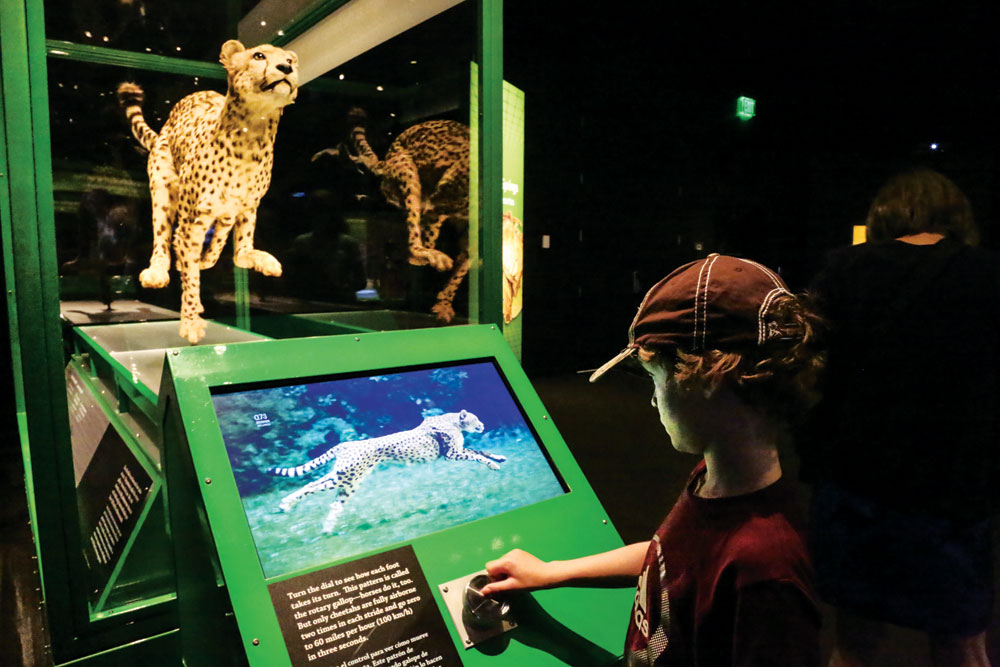
Jake Brownell operates a video of a running cheetah at the Nature’s Amazing Machines exhibit at Denver Museum of Nature and Science. The cheetah’s stride can be observed by slowing the video or making it go backwards. Cheetahs are the world’s fastest land mammals, able to go from zero to 60 miles per hour in three seconds.
Have you wondered why a duck’s feet don’t freeze in icy water? What makes a cheetah the world’s fastest land mammal? How do insects breathe without lungs? How do a Fennec fox’s large ears keep it cool in the African desert?

Jake Brownell examines a toucan and a duck. Toucans use their beak as an air conditioner to regulate body temperature. Blood vessels flow close to the surface of the beak, where air temperatures cool it down. A duck’s arterial system interweaves warm and cold blood, keeping the feet cool and providing just enough heat to keep them from freezing.
“Nature’s Amazing Machines,” at the Denver Museum of Nature and Science through Jan. 1, demonstrates the marvels of natural engineering that help living things survive. “This exhibition reveals a myriad of incredible adaptations animals possess that allow them to propel themselves through the air, water and on land, escape predators and find food despite fierce competition,” said Dr. Garth Spellman, curator of ornithology at DMNS and curator of “Nature’s Amazing Machines.”

Gisselle Ortiz-Lopez and Erick Ortiz laugh as they squeeze a ball to pump “blood” from a giraffe’s heart to its brain. Giraffes have high blood pressure and a small but powerful heart.
The exhibition, presented in both English and Spanish, invites the whole family to try out nature’s machinery. Kids can learn to “fly” by propelling themselves with hand-held wings of different types, and operate the jaw mechanisms of fish to catch their prey. A challenging hands-on station lets visitors try to pump blood from the heart of a giraffe all the way up to its brain. “It’s hard to do because the pump requires the amount of pressure the giraffe actually needs,” said Neha Gidvani, a program specialist at DMNS.

Kids “fly” in a swivel chair using wings of different shapes. Short, fat wings, like those of a snow goose, make it easier to get off the ground quickly, while the longer wings of an albatross allow it to fly long distances. Birds from the museum’s own collection fly overhead.
A video installation explores the insulators and radiators used by animals to regulate their temperature in extreme climates. Exploration stations let kids touch a variety of protective structures, including shells and bones, to discover why the dome shape—eggs, turtle shells and human skulls—provides ideal protection.
“The exhibit is very interactive because we want people to discover nature’s incredible biodynamics,” said Gidvani. “Human engineers are inspired by nature in all kinds of ways.”
Engineering success stories inspired by nature include Velcro, which impersonates burrs from plants. Other modern inventions based on nature’s ingenuity include wind turbines and chainsaws. Bio-mimicry also helps humans engineer better prosthetics, shown in videos of a runner with an artificial leg. “We learn how to solve problems using nature as a guide,” said Spellman.
Young visitors can take home collectible trading cards, featuring six different animals from the exhibition and activities to try at home. The cards are printed in both English and Spanish. “There’s so much to do, we encourage families to come back multiple times—and collect all of the cards,” said Gidvani.
The Denver Museum of Nature & Science is at 2001 Colorado Blvd., open 9am–5pm every day. “Nature’s Amazing Machines” is free with general admission. For more information, see www.dmns.org/NAM or call 303.370.6000.

Participants stand in front of a thermal camera that reveals where our bodies lose heat the fastest.

Rapid heat loss occurs in the lighter areas, while heat escapes more slowly in the dark purple area.
Nature’s Amazing Machines from Steve Larson on Vimeo.



0 Comments